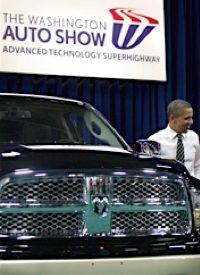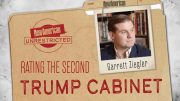
During a surprise visit to the Washington Auto Show Tuesday, President Obama touted his administration’s efforts in re-energizing the U.S. automobile industry, while castigating those who were “willing to let the industry die.” Trumpeting American ingenuity and economic achievement, the President hopes to capitalize on the “government rescue” of General Motors and Chrysler as a political advantage for his 2012 reelection campaign.
Obama viewed up close and even sat inside more than a dozen new electric and hybrid vehicles from GM, Ford, and Dodge. “Let me just say, when you look at all these cars, it is testimony to the outstanding work that’s been done by workers — American workers, American designers,” Obama asserted as he inspected the new models on the showroom floor. “The U.S. auto industry is back.”
Using GM’s revival as a case study of the White House’s support for U.S. manufacturing, the President reminded the crowd that despite intense criticism from his opponents, he stood by his word to pump billions of dollars into GM and Chrysler during a time when both companies were battling stagnant economic growth. In a brief speech, Obama made sure to highlight this “achievement.”
“It’s good to remember the fact that there were some folks who were willing to let this industry die. Because of folks coming together, we are now back in a place where we can compete with any car company in the world,” he affirmed. “And these are not only selling here in the United States, they also serve as a platform for us to sell product all around the world.”
All the current GOP presidential candidates opposed the bailouts, and the Obama campaign has made it a point to illustrate this distinction. Former Massachusetts Governor Mitt Romney was particularly critical of the bailout, as he wrote a now-famous article in 2008 in the New York Times, entitled “Let Detroit Go Bankrupt,” which castigated the federal government for its proposal to bail out the automakers. “It won’t go overnight,” Romney averred, but if so, “you can kiss the American automotive industry goodbye.”
While not specifically mentioning Romney by name, the Obama campaign has strategically used the U.S. automaker storyline as an argument against the former Massachusetts Governor.
Romney has since clarified his stance on the bailout, assuring that he wasn’t advocating that the automakers go under but rather to proceed through a “managed bankruptcy.” “Events have proved Governor Romney exactly right,” Romney spokeswoman Andrea Saul said Tuesday. “As he said back in 2008, a managed bankruptcy was the right course for the automakers, and he is thrilled to see that they have successfully re-emerged from the bankruptcy process as he expected they would. It is unfortunate that the government first attempted a bailout, which was precisely as unsuccessful as he predicted, cost taxpayers billions, and left the government improperly entangled in the private sector.”
In any case, Obama championed the bailout in his State of the Union address, declaring, “GM is back on top as the world’s number one automaker. Chrysler has grown faster in the U.S. than any major car company. Ford is investing billions in U.S. plants and factories. And together, the entire industry added nearly 160,000 jobs. We bet on American workers. We bet on American ingenuity. And tonight, the American auto industry is back.”
Both Obama and President George W. Bush found their administrations in unexplored territory in the fall of 2008 and early 2009, as GM, Chrysler, and Ford were teetering on the edge of financial insolvency. Bush intervened and delivered $17.4 billion in loans, while requiring GM and Chrysler to implement government-mandated restructuring plans.
Obama funneled billions more into GM and Chrysler, mandating concessions from industry stakeholders and authorizing the companies to proceed with swift bankruptcies. White House aides claimed that the government aid, clocking in at about $85 billion, was imperative because funding the bankruptcies privately, they contended, would be improbable and the two companies would be forced to liquidate.
Critics allege that the President is attempting to use the decision as a political ploy to rally support in Ohio, and in Michigan, where unemployment lingers just below 10 percent, a substantial hike above the national average. Although Obama carried both states in 2008, new polls show that the President is standing in dangerous territory.
A Quinnipiac University poll in Ohio released January 18 showed Obama tangling in a virtual tie with Romney, with 50 percent disapproving of the President’s performance in the White House. A Lansing-based EPIC-MRA poll in Michigan released last week concluded that 48 percent currently support Obama and 40 percent support Romney.
Most Republicans contend that the general public still disagrees with the bailout, and that government intervention in the auto industry was hardly the ideal solution. “The industry was bailed out but a lot of people lost their jobs,” said Michigan-based Republican strategist David Doyle.
The federal government, which has come to champion private bailouts now more than ever, owns more than a quarter of GM, and the Treasury Department will lose more than $23 billion on the auto bailout.
Obama’s appearance at Tuesday’s auto show is yet another example of the White House seizing every opportunity to attract praise for its efforts to reignite the auto industry, as staffers relentlessly tout job growth and GM’s powerful reemergence in the domestic auto market. “The fact that GM is back, number one, I think shows the kind of turnaround that’s possible when it comes to American manufacturing,” the President crowed.
Virtually every other sector of the economy has either worsened or remained economically stale since Obama took office. And with that under consideration, the President plans to brand his “rescue” of the U.S. auto industry as a victory for jobs and domestic manufacturing — even though taxpayers still retain a multibillion-dollar bailout bill.
Photo (above and left): President Barack Obama looks at Dodge Ram truck during his visits to the Washington Auto Show, Tuesday, Jan., 31, 2012 in Washington: AP Images



